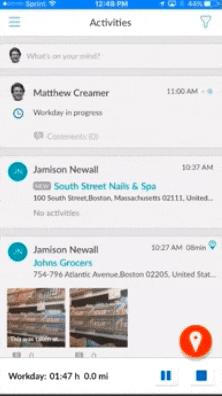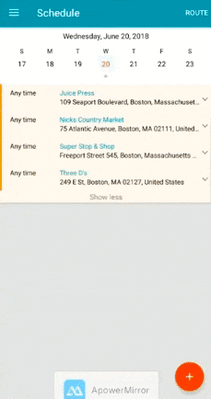As a sales manager, you’re always looking for areas where your team can boost performance. With all of the activities that you and your reps do in a given day, how can you iterate and adapt your process to get the best results?
The answer is by better managing sales activities.
Sales activity management is a hands-on, proactive method to identify and prioritize the daily actions that directly correlate to sales. By monitoring and analyzing the routine operations of your reps, you can get data-driven insight into how your team can sell more.
Why Is Activity Management Important?
The ultimate goal of any salesperson is to close more deals, but only a fraction of their daily routine is spent actually doing that. The majority of time is spent doing all of the little things that lead up to closed sales, like making calls or setting up meetings.
But how many of these activities are actually direct drivers of success? Are there any activities that are just “busy work” and don’t lead to many results? How can you best optimize your team’s actions to find the most efficient track to revenue?
Activities data can help to answer all of these questions. It’s all about working smarter, not harder. More and more sales teams are starting to realize the value in sales activity management. In fact, a recent survey determined that 75% of sales managers are either currently investing in or plan to invest in sales activity management software.
The goal behind activities management is to create an optimized chain of controllable activities that lead directly to sales. For sales teams that are struggling or are simply looking to take their results to the next level, managing activities could be just what you need.
The Problem With Pipeline
It’s common for sales teams to be overly focused on their pipeline. Pipeline is of course important because it contains details about all prospective customers, such as how long they’ve been in contact or the estimated close date, but these details alone aren’t enough to get that boost in sales you’re looking for.
The main issue with focusing solely on pipeline is that it only looks at the surface level and at the end result, but not the driving forces behind it. Not to mention that many pieces of information within the pipeline are often not backed by data, but are rather reported subjectively from your team. Salespeople tend to be optimistic when reporting the likelihood of a close, and the data that they report is often only based on hunches.
Instead, accurate, quantifiable data about the activities your team performs day in and day out leads to better planning, execution, and prediction of your pipeline. Now we’ll take a better look into three different ways to use activity management to boost your numbers.
1. Work Smarter, Not Harder
More activities doesn’t necessarily mean more sales. It’s possible that some of the calls, demos, or visits that you do aren’t leading to closed deals at the end of the sales cycle. With the busy schedule that your team works, wouldn’t it be better if you could focus more on the activities that actually lead to the most closes?
By having your reps record every activity that they do and then monitoring their results, you get a much better picture of the chain of events that lead to that eventual close. For example, you might start to notice that the reps who make more calls are closing more deals. Maybe it’s something less obvious, such as what day of the week leads are contacted. Whatever the trends may be, you now have a new level of insight into what actually drives sales, and what activities are only taking up time.
Use a mobile activities form like this one to monitor the activities of your reps across all accounts, and make analyzing them for trends easier.

2. Organize and Course Correct
Once you’ve identified the activities that drive your sales, make sure they are happening more frequently. Oversee the sales process of your team, and organize it so that the most time is spent doing the most productive things.
For example, if your data indicates that it’s calls that lead to sales, increase the number of calls that your reps make. Perhaps the accounts that your reps have made in-person demos at are generating the most revenue. Increase the number of visits they do while optimizing their travel routes to get the most out of their time.
On the flip side, decrease the amount of time doing activities that aren’t the key drivers of closed sales, to prevent wasting time on busy work. While these actions may still be important to a degree, there’s no need to spend excessive amounts of time doing them if they aren’t directly affecting your sales in a positive way.
As a manager, take this opportunity to have a more direct role in your team’s daily routine. Use the activities data you’ve collected to organize their schedules and actions around being more efficient and time-effective. As your brand evolves, you can course-correct and iterate your process in real time to be more agile as a team. This shouldn’t feel like micromanaging, but rather guiding your team towards success using supporting activities data.

3. Use Data for More Accurate Forecasting
Having this activities data and using it to create an optimized sales process will benefit your sales forecasts as well. Like we mentioned earlier, focusing too much on the pipeline often leads to bias and to projections that are based on hunches rather than hard data. Once you know concretely the activities that are highly correlated with closed deals, you and your team can better gauge the progress that’s been made with each prospect.
Suppose your activities data dictates that in order to close a deal, your team needs to make a certain number of calls to leads and perform a certain number of demos. By quantitatively estimating how many of each activity must be completed before a sale, you get a more accurate and detailed idea of the likelihood of closing.
For example, let’s say you determine that, on average, accounts don’t close until they’ve been contacted three times and participated in two demos of your product. Now your reps have an activities standard to measure their progress against. This is a far more accurate predictor of sales than any hunch or subjective evaluation. Every potential customer is different, and your reps’ intuition about their interactions is valuable, but it is much stronger when coupled with your data.
It’s often said to “trust the process,” but this old saying can be improved. Instead, “win the process” by constantly monitoring, analyzing, and adapting your team’s daily activities. Identify and promote the actions that are direct drivers of success, while cutting down on time wasting tasks to be more efficient and productive as a whole.




.png?width=480&height=252&name=PRESS%20RELEASE-2%20(4).png)

